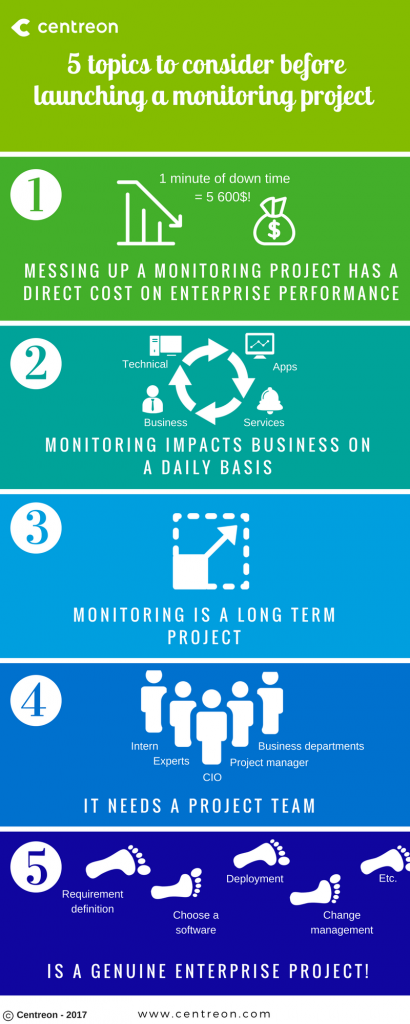Through experience, we know that many monitoring projects start when an intern arrives in the company (it’s even how Centreon was born) and is put under the orders of an overworked “adminsys” who follows the project as best they can. With Enterprise and business digitization, IT monitoring has become as crucial as critical for enterprise performance. It is a fully-fledged enterprise project that requires a true thought process on what’s at stake before being deployed.

Topic n°1: Messing up a monitoring project has a direct cost on enterprise performance
Let’s start with some numbers: the IHS design office estimated the annual cost of IT downtime in US companies in 2015 at 700 billion dollars, or an average cost of one million dollars per year for an ETI. As for Gartner, in 2014 they estimated the average cost of a network failure at 5,600 dollars per minute of down time, or 300,000 dollars per hour! The direct consequences: loss of revenue and a drop in productivity that directly impact performance and the bottom line! A monitoring project is therefore a high stakes enterprise project that deserves a lot more attention than a basic end of studies internship subject.
Topic n°2: Monitoring is no longer limited to creating alerts, it impacts business on a daily basis
Alongside the digital transformation and enterprise digitization, the classic technical infrastructure monitoring has given way to the monitoring of services offered to both internal and external users. Besides technical monitoring (network, infrastructure and hardware monitoring), teams also monitor applications and quality of service (compliance with contractual indicators and user experience) and increasingly monitor business processes. As the fate of the IT department (and therefore of IT monitoring) is now linked to business departments, knowledge of the enterprise, user expectations and the most relevant indicators has become essential to the success of a monitoring project. Business departments must be consulted, empowered and associated with the acceptance of the service.
Topic n°3: Monitoring is a long term project
The continuous improvement principle is at the heart of monitoring management. The information system and infrastructure are constantly evolving. Deploying a monitoring system is a good thing. Making it live is even better. The “Plan, Do, Check, Act” ITIL scheme fully applies to monitoring. So giving the project to an intern may be complicated to manage over the long term, especially if we forget (as is often the case) to ask them what they did during their internship. A monitoring system is a living thing and must continuously improve to anticipate and predict failures using history and the analysis of collected data. Such a project requires creating a team that will promote monitoring and make it possible for a wider population to improve its operational performances. The “monitoring” expert must be there from the very first project design phases in order to qualify and define the scope of the need. Their work must not be limited to the integration phases.
Topic n°4: A monitoring project needs a project team (and not just a guy in a room!)
A project means a team. It’s especially hard to consider an intern as a “one man project team”, because they would have difficulty in being sufficiently credible to carry the project. A “monitoring project” team requires manpower and ideally should look like this:
- A sponsor who should be the IT manager and guarantees quality of service to users,
- A project manager and a change management team,
- An implementation team, including the intern, and all the experts (application, infrastructure, etc.), without forgetting the final users.
Topic n°5: In fact, monitoring is a GENUINE enterprise project
If the initial monitoring project scope doesn’t always seem strategic, the enthusiasm it will generate and its scheduled evolution require it to be considered as such to be able to anticipate and accelerate the project when the time comes. It requires a true organization worthy of the name, with phases, resources and questions: what data to collect in what scope? What should be done with the data? Who will have access to the data? How can business departments be included in the project? What reporting should be deployed to give the IT department’s work added value? Which tool should be selected? Which interactions with third party software are relevant? How should the project be set up and how should it be assessed and continuously moved forward?
In short, as you will have understood, implementing a monitoring project is a project that has its place at the heart of the enterprise IT strategy and impacts all business. A big and magnificent project which an intern can be part of (and “enjoy”!), but not one they can be in charge of.





